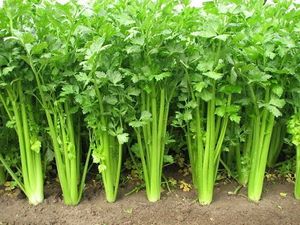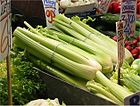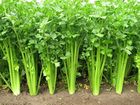Note: This is a project under development. The articles on this wiki are just being initiated and broadly incomplete. You can Help creating new pages.
Difference between revisions of "Apium graveolens - Ugragandhika, Celery"
(→External Links) |
(→External Links) |
||
| Line 81: | Line 81: | ||
* [https://www.growveg.com/guides/growing-celery-two-ways/ Celery-growing ways] | * [https://www.growveg.com/guides/growing-celery-two-ways/ Celery-growing ways] | ||
[[Category:Herbs]] | [[Category:Herbs]] | ||
| + | [[Category:Ayurvedic herbs that don't have flower, fruit and leaf photos]] | ||
| + | [[Category:Ayurvedic herbs that don't have seed photos]] | ||
Revision as of 15:15, 14 May 2019
Apium graveolens var is a marshland plant in the family Apiaceae that has been cultivated as a vegetable since antiquity. Celery has a long fibrous stalk tapering into leaves. Depending on location and cultivar, either its stalks, leaves, or hypocotyl are eaten and used in cooking.Celery seed is also used as a spice; its extracts are used in Ayurvedic medicine.
Contents
- 1 Uses
- 2 Parts Used
- 3 Chemical Composition
- 4 Common names
- 5 Properties
- 6 Habit
- 7 Identification
- 8 List of Ayurvedic medicine in which the herb is used
- 9 Where to get the saplings
- 10 Mode of Propagation
- 11 How to plant/cultivate
- 12 Commonly seen growing in areas
- 13 Photo Gallery
- 14 References
- 15 External Links
Uses
Blood pressure, Indigestion, Uterus, Inflammatory, Hysteria, High blood pressure, Rheumatism, Diarrhea, Kidney complaints.
Parts Used
Chemical Composition
The constituents of the celery include glycosides, steroids, and different types of phenolic including furanocoumarins, flavones, and trace elements[1]
Common names
| Language | Common name |
|---|---|
| Kannada | |
| Hindi | Bari ajmod, Ajmod |
| Malayalam | |
| Tamil | |
| Telugu | |
| Marathi | NA |
| Gujarathi | NA |
| Punjabi | NA |
| Kashmiri | NA |
| Sanskrit | Ugragandhika, Vastamoda, Hayagandha |
| English | Celery, Wild Celery |
Properties
Reference: Dravya - Substance, Rasa - Taste, Guna - Qualities, Veerya - Potency, Vipaka - Post-digesion effect, Karma - Pharmacological activity, Prabhava - Therepeutics.
Dravya
Rasa
Katu (Pungent), Tikta (Bitter)
Guna
Laghu (Light), Ruksha (Dry)
Veerya
Ushna (Heating)
Vipaka
Katu (Pungent)
Karma
Prabhava
Habit
Identification
Leaf
| Kind | Shape | Feature |
|---|---|---|
| Simple | Celery leaves are frequently used in cooking to add a mild spicy flavor to foods, similar to, but milder than black pepper |
Flower
| Type | Size | Color and composition | Stamen | More information |
|---|---|---|---|---|
| Unisexual | 1-3cm long | Yellow | 5 | Flowers Season is June - August |
Fruit
| Type | Size | Mass | Appearance | Seeds | More information |
|---|---|---|---|---|---|
| rounded | 4-10cm long | With hooked hairs | single | {{{6}}} |
Other features
List of Ayurvedic medicine in which the herb is used
- Vishatinduka Taila as root juice extract
Where to get the saplings
Mode of Propagation
How to plant/cultivate
Prefers a rich light moist soil with some shade in summer[3]
Commonly seen growing in areas
Wild in Europe, Mediterranean region, Himalayas.
Photo Gallery
References
External Links
- Ayurvedic Herbs known to be helpful to treat Blood pressure
- Ayurvedic Herbs known to be helpful to treat Indigestion
- Ayurvedic Herbs known to be helpful to treat Uterus
- Ayurvedic Herbs known to be helpful to treat Inflammatory
- Ayurvedic Herbs known to be helpful to treat Hysteria
- Ayurvedic Herbs known to be helpful to treat High blood pressure
- Ayurvedic Herbs known to be helpful to treat Rheumatism
- Ayurvedic Herbs known to be helpful to treat Diarrhea
- Ayurvedic Herbs known to be helpful to treat Kidney complaints
- Herbs with Leaves used in medicine
- Herbs with Seeds used in medicine
- Herbs with common name in Hindi
- Herbs with common name in Sanskrit
- Herbs with common name in English
- Habit - Biennial herb
- Index of Plants which can be propagated by Seeds
- Herbs that are commonly seen in the region of Wild in Europe
- Herbs that are commonly seen in the region of Mediterranean region
- Herbs that are commonly seen in the region of Himalayas
- Herbs
- Ayurvedic herbs that don't have flower, fruit and leaf photos
- Ayurvedic herbs that don't have seed photos





